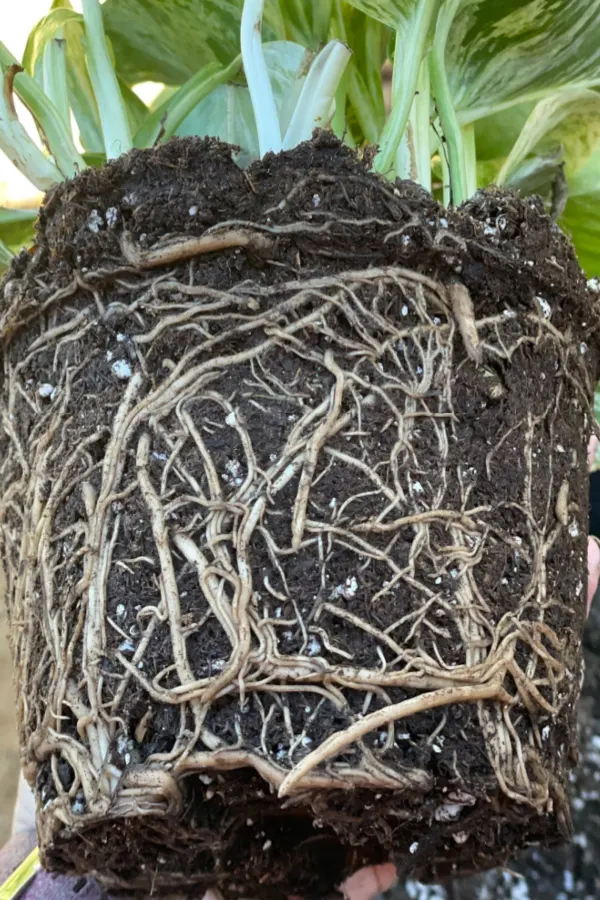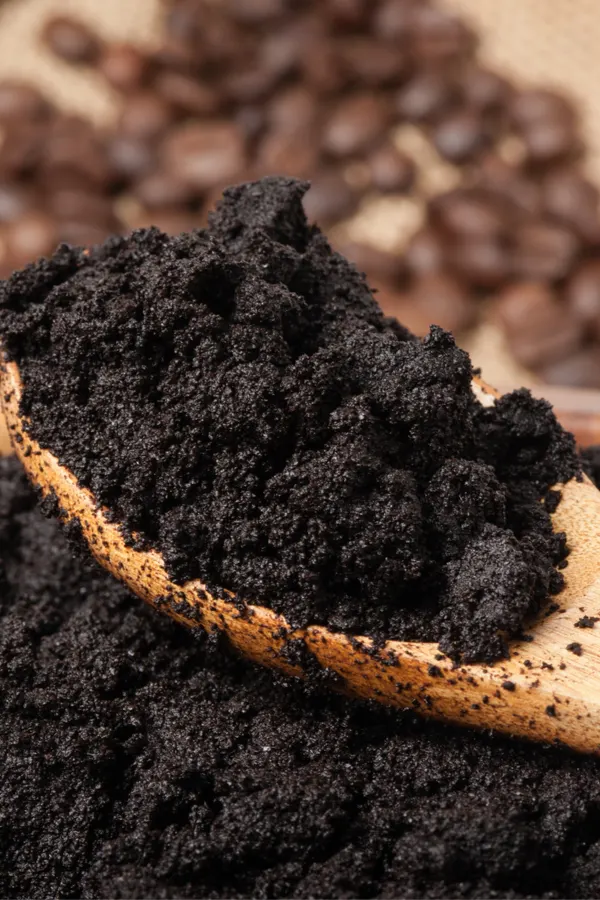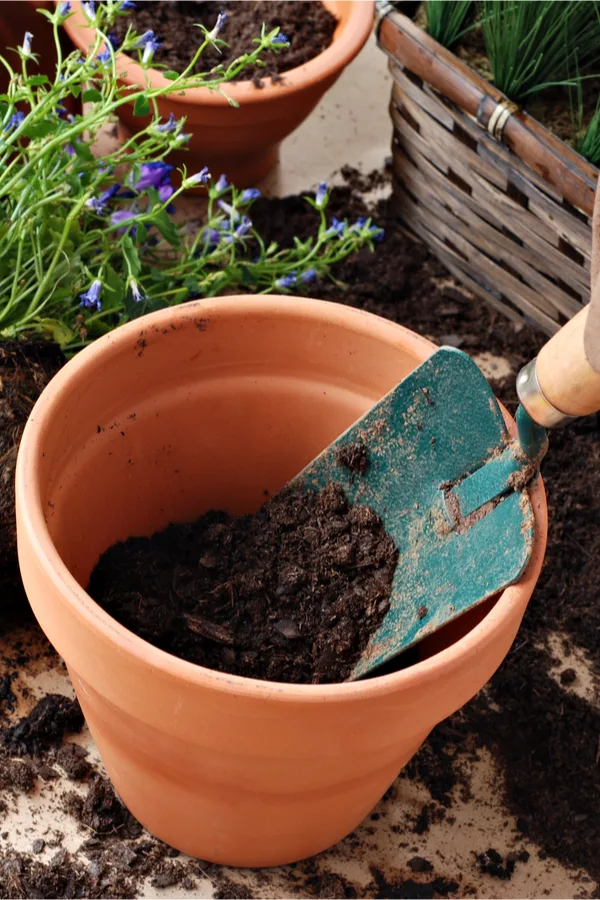Looking for a way to save the old potting soil from your hanging basket and containers at the end of the season to use again next year?
If there is one thing that seems to break a gardeners budget each and every spring – it’s having to purchase all new potting soil for their hanging baskets, containers and potted plants. Let’s face it, potting soil is expensive. And it can get quite pricey having to replace it every single spring.
But here is the good news – you don’t have to keep wasting your hard earned dollars buying all new potting soil at the start of every garden season. Especially when you see how easy it is to save and recharge that tired old soil and use it again!

Giving A Second Life To Old Potting Soil – How To Save & Reuse Potting Soil From Hanging Baskets & Containers
By the end of the season, the soil in container plants is usually dry, crusty and crumbly. In addition, it also usually has a fair amount of the roots weaving all throughout. In fact, by late summer, most potted plants and containers are completely root bound. So much so that they will simply slide out of their container when turned over.
It’s true that at this point most of the soil’s nutrients are long gone. But one thing is for sure – that old soil still has plenty of value. And, with just a bit of work, you can bring it back to life.
For starters, old potting soil is light and contains plenty of organic matter. And the old roots from the plants weaving through it have a lot of nutrient value as well. Especially once they break back down.
The key to being able to save your old soil and use it again is to simply add back what it needs to be rich and fertile again. And there actually a couple of simple, quick and very inexpensive ways to do it!

With that in mind, here is a look at two of the best ways to recycle and reuse both the soil and foliage in your hanging baskets each fall. And in the process, greatly reduce your potting soil expenses every spring!
How To Save & Reuse Old Potting Soil From Hanging Baskets & Containers
Create A Potting Soil Compost Pile – How To Recycle Hanging Basket Soil
One of the easiest and best methods of all for saving, recharging and reusing old potting soil it to create your own potting soil compost pile. This is different than putting the old soil into an existing pile, but instead making a new pile exclusively for your old potting soil.
As you will see below, this allows you to add simple but fast decomposing materials to the pile in late fall, over the winter and in early spring. Those materials then recharge the old soil and have it teeming with energy for spring planting.
For those that plant a fair amount of container plants each year, this is the perfect method. Not only does it give you a single space to empty out all of your plants at the end of the growing season, it also gives you easy access for ready-to-go potting soil next spring.

How To Create A Potting Soil Compost Pile – How To Save & Reuse Potting Soil
You can create a soil recharging bin anywhere and from nearly anything. In a corner of your garden, in and old wheelbarrow, a 55 gallon drum or even an actual compost bin. The key is to select an area that will hold all of your old soil plus a bit of additional material as well.
To create your recharging pile, begin by dumping in all of the old soil from your pots and baskets. Include all of the roots within the soil, chopping them up as you add them. This is important to get tough roots breaking down fast.
Next, chop up all of the foliage from the plants that were growing in the container. They too have a lot of value as they break down. Once again, cut them up as small as possible to speed decomposition.
One of the fastest and easiest ways to do this is to run over the foliage with a push mower. It will chop the foliage up to a fraction of its size in seconds. And if you happen to have a bagging attachment, you can easily dump it right into your pile!

Recharging The Soil – How To Save & Reuse Potting Soil
Now it’s time to add in some additional composting materials that will quickly break down and recharge the soil. This includes green grass clippings, shredded leaves, coffee grounds and chopped vegetable peels. They key is to only put in materials that are shredded and small as these break down quickly.
Add these materials as often as you can until late fall. As for how much to add – a good rule of thumb is to try to double the size of the soil mass. Always mix as you add to help the pile heat and break down new materials fasters.
By stopping in late fall, this gives the new materials enough time to completely break down and recharge into the soil. Over the winter, you can continue to add coffee grounds to your potting soil pile. Not only are they full of nutrients, they don’t need additional time to break down.
When spring arrives, to finish recharging your soil, mix in a bit of new potting soil and worm castings to the soil mix. These will help to push the soil fertility over the top and really have your plants growing better than ever. Affiliate Product Link : Pure Worm Castings

As for how much, a good rule of thumb is to add 1 cup of worm castings and 3 cups of new potting soil for every 15 to 20 cups of old potting soil. Just like that, you are ready to grow again with healthy, vibrant soil. And at a fraction of the cost!
Adding Old Potting Soil To Your Existing Compost Bin – How To Save & Reuse Potting Soil From Containers & Hanging Baskets
Even if you can’t build your own potting soil recharging station, at the very least, add that old soil to your regular compost bin! See: How To Build Your Own Compost Bin With Ease
When it comes to giving a second life to old hanging basket and container soil, it’s hard to beat composting. Both the soil and foliage of hanging baskets plants are the perfect addition to a fall compost pile.
What makes the spent container soil and foliage so valuable for a compost pile is that it adds instant substance. The old soil mixes easily into a pile and quickly break down leaves, twigs and many of the other additions to a fall compost pile.

As they do, they in turn help to create a finished compost that is teeming with nutrients. And that nutrient-filled humus is great for mixing in equal parts with new potting soil next spring to power your potted plants once again. It may not be be pure potting soil, but it certainly is the next best thing!
Here is to saving your old potting soil this fall and reusing it again!
Follow Our Facebook Page For Great Gardening Tips And Advice! This Is My Garden Facebook Page
This Is My Garden is a garden website created by gardeners, for gardeners. Jim and Mary Competti have been writing gardening, DIY and recipe articles and books and speaking for over 15 years from their 46 acre Ohio farm. They publish three articles every week, 52 weeks a year. Sign up today to follow via email, or follow along!
